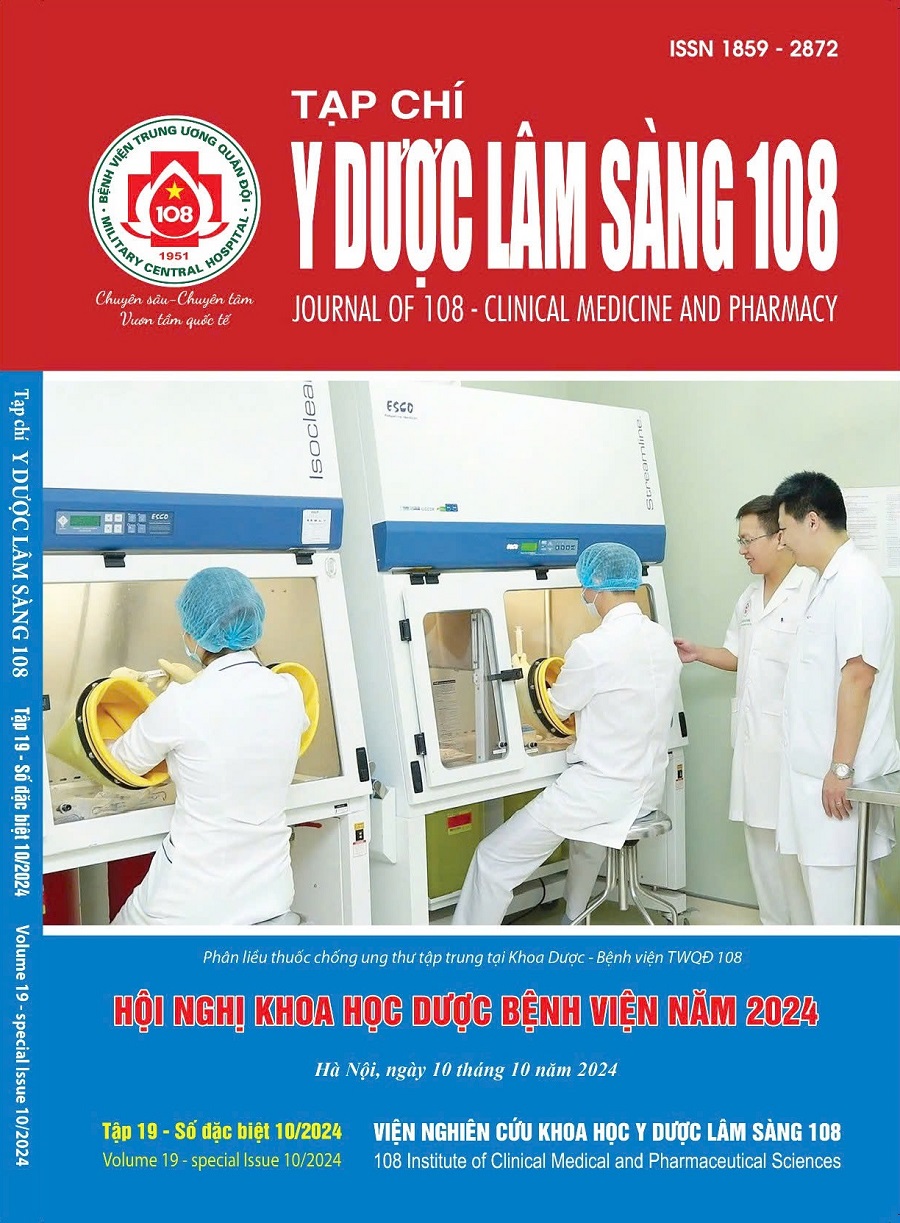External validation of population pharmacokinetic models of vancomycin in adult patients at 108 Military Central Hospital
Main Article Content
Keywords
Abstract
Objective: The study was conducted to determine the best predictive population pharmacokinetic (popPK) model for vancomycin in patients at the 108 Military Central Hospital. Subject and method: External validation was used to evaluate the predictive ability of published popPK models of vancomycin in the literature based on dataset of vancomycin blood concentrations from 98 adult patients at the hospital from December 2020 to August 2022. Result: 28 popPK vancomycin models from 270 studies in the literature were selected for validation of their suitability. The Yamamoto-2 (2009) model demonstrated the best predictive performance for actual vancomycin concentrations, with a mean prediction error (MPE) and mean absolute prediction error (MAPE) of 0.08mg/L and 18.9%, respectively (indicating good predictive performance). The goodness of fit (GOF) plot and visual predictive check (VPC) plot of this model also demonstrated a good fit between predicted concentrations and observed data. Conclusion: The Yamamoto-2 (2009) model was identified as the most accurate for predicting vancomycin concentrations in patients at 108 Military Central Hospital. The study results provide a foundation for the development of precision dosing tools based on the appropriate model, aimed at improving the effectiveness of therapeutic drug monitoring services at the hospital in the future.
Article Details
References
2. Kumar AA, Burgard M, Stacey S, Sandaradura I, Lai T, Coorey C, Cincunegui M, Staatz CE, Hennig S (2019) An evaluation of the user‐friendliness of Bayesian forecasting programs in a clinical setting. British journal of clinical pharmacology 85(10):
2436-2441.
3. Turner RB, Kojiro K, Shephard EA, Won R, Chang E, Chan D, Elbarbry F (2018) Review and validation of Bayesian dose‐optimizing software and equations for calculation of the vancomycin area under the curve in critically ill patients. Pharmacotherapy 38(12): 1174-1183.
4. Fuchs A, Csajka C, Thoma Y, Buclin T, Widmer N (2013) Benchmarking therapeutic drug monitoring software: A review of available computer tools. Clinical pharmacokinetics 52: 9-22.
5. Keizer RJ, Ter Heine R, Frymoyer A, Lesko LJ, Mangat R, Goswami S (2018) Model-Informed Precision Dosing at the Bedside: Scientific Challenges and Opportunities. CPT Pharmacometrics Syst Pharmacol 7(12): 785-787.
6. Methaneethorn J, Lohitnavy M, Onlamai K, Leelakanok N (2022) Predictive performance of published tacrolimus population pharmacokinetic models in Thai kidney transplant patients. Eur J Drug Metab Pharmacokinet 47(1):105-116. doi: 10.1007/s13318-021-00735-8.
7. Parra González D, Pérez Mesa JA, Cuervo Maldonado SI, Díaz Rojas JA, Cortés JA, Silva Gómez E, Saavedra Trujillo CH, Gómez J (2022) Pharmacokinetics of vancomycin among patients with chemotherapy-associated febrile neutropenia: which would be the best dosing to obtain appropriate exposure? Antibiotics (Basel) 11(11):1523. doi: 10.3390/antibiotics11111523.
8. Yamamoto M, Kuzuya T et al (2009) Population pharmacokinetic analysis of vancomycin in patients with gram‐positive infections and the influence of infectious disease type. Ournal of clinical pharmacy and therapeutics 34(4): 473-483.
9. Medellín-Garibay SE, Ortiz-Martín B, Rueda-Naharro A, García B, Romano-Moreno S, Barcia E (2016) Pharmacokinetics of vancomycin and dosing recommendations for trauma patients. The Journal of antimicrobial chemotherapy 71(2): 471-479.
10. Moore JN, Healy JR et al (2016) A population pharmacokinetic model for vancomycin in adult patients receiving extracorporeal membrane oxygenation therapy. CPT: Pharmacometrics & systems pharmacology 5(9): 495-502.
11. Revilla N, Martin-Suarez A et al (2010) Fernandez de Gatta MdM: Vancomycin dosing assessment in intensive care unit patients based on a population pharmacokinetic/pharmacodynamic simulation. British journal of clinical pharmacology 70(2): 201-212.
12. Dolton M, Xu H, Cheong E, Maitz P, Kennedy P, Gottlieb T, Buono E, McLachlan AJ (2010) Vancomycin pharmacokinetics in patients with severe burn injuries. Burns: Journal of the International Society for Burn Injuries 36(4): 469-476.
13. Aljutayli A, Thirion DJG, Bonnefois G, Nekka F (2022) Pharmacokinetic equations versus Bayesian guided vancomycin monitoring: Pharmacokinetic model and model‐informed precision dosing trial simulations. Clinical and translational science, 15(4): 942-953.
14. Guo T, van Hest RM, Roggeveen LF, Fleuren LM, Thoral PJ, Bosman RJ, van der Voort PHJ, Girbes ARJ, Mathot RAA, Elbers PWG (2019) External evaluation of population pharmacokinetic models of vancomycin in large cohorts of intensive care unit patients. Antimicrob Agents Chemother 63(5):e02543-18. doi: 10.1128/AAC.02543-18.
15. Lê Bá Hải, Nông Hồng Thạch và cộng sự (2023) Thực trạng giám sát nồng độ vancomycin trong máu và hiệu chỉnh liều trên bệnh nhân người lớn điều trị tại Bệnh viện Trung ương Quân đội 108. Tạp chí y dược lâm sàng 108, tr. 159-166.
16. Cunio CB, Uster DW, et al (2021) Towards precision dosing of vancomycin in critically ill patients: An evaluation of the predictive performance of pharmacometric models in ICU patients. Clinical microbiology and infection: The official publication of the European Society of Clinical Microbiology and Infectious Diseases 27(5): 777-783.
17. Trương Thanh Long, Lê Bá Hải và cộng sự (2022) Thẩm định ngoại tính phù hợp của mô hình dược động học quần thể vancomycin trên bệnh nhân điều trị tại Bệnh viện đa khoa Xanh Pôn. Tạp chí Y học Việt Nam, 515(2), tr. 195-200.
 ISSN: 1859 - 2872
ISSN: 1859 - 2872
